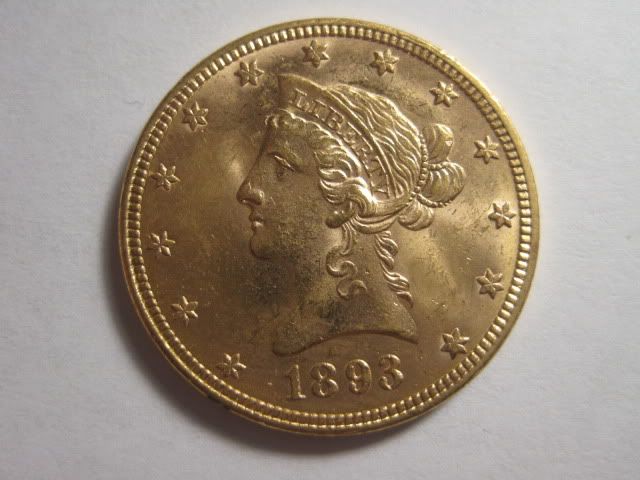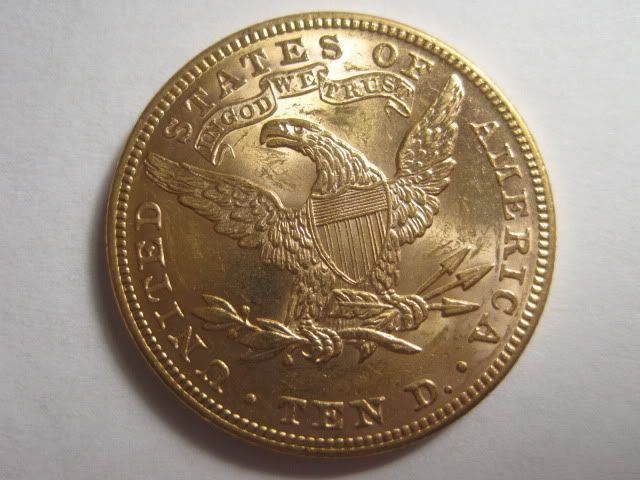The waiting is the hardest part... Grades are in !
 Meltdown
Posts: 8,844 ✭✭✭✭✭
Meltdown
Posts: 8,844 ✭✭✭✭✭
I've only ever had one other gold piece graded. It was a 1900 $20 piece that came back
as "altered surfaces". I was very surprised and couldn't tell at all what had been done to it.
These 2 I've had for a while now... Both were purchased raw. I sent them off to our host almost 2 weeks ago.
I think they're original but I also don't know crap about grading gold.
Care to guess what they will grade?


1914 Indian


as "altered surfaces". I was very surprised and couldn't tell at all what had been done to it.
These 2 I've had for a while now... Both were purchased raw. I sent them off to our host almost 2 weeks ago.
I think they're original but I also don't know crap about grading gold.
Care to guess what they will grade?


1914 Indian


0
Comments
Good luck, I hope you get them back soon!
I've got everything I need - almost.
Britannia, Maple, Osterreich, Eagle, Fantasy coins and whatever else gets in my way.
Liberty: Parent of Science & Industry
<< <i>Beautiful coins... I don't know anything about grading these either but I had to ask - Is the 1914 design from De Francisci, the same designer of the Peace Dollar? That sure looks like Teresa De Francisci.
Good luck, I hope you get them back soon! >>
Not the same designer, but you are correct in that they do look somewhat similar.
Click on this link to see my ebay listings.
I've entered the "nonstop refresh" stage of my last submission. This submission received by PCGS the same day as mine and also a Modern tier of similar coins just posted...I'm hoping my submission turns out as well on the CAM/DCAM side.
<< <i>62 and 63 ?????? >>
I hope so. I think the the $10 gold liberty could grade MS64 - but that's seriously wishfull thinking on my part.
I bought the $10 Indian as AU58 because I think there is just the slightest rub oin the high points. The fields
and raised devices are remarkably clean from nicks & ticks however... so maybe AU58+ ?
We shall see... they both could just as easily come back as genuine for as much as I know...
Click on this link to see my ebay listings.
Many members on this forum that now it cannot fit in my signature. Please ask for entire list.
<< <i>I hope I am wrong, but the 1893 looks not genuine? >>
<< <i>I can't comment on genuine, but you have the 1893 in hand, the roughness on the surfaces seem out of the ordinary. >>
Stop freaking me out!
I think it may be just my photos.
There is no roughness that I can recall, I can't double check because the coins are in PCGS's hands now.
Click on this link to see my ebay listings.
Many members on this forum that now it cannot fit in my signature. Please ask for entire list.
<< <i>Beautiful coins... I don't know anything about grading these either but I had to ask - Is the 1914 design from De Francisci, the same designer of the Peace Dollar? That sure looks like Teresa De Francisci.
Good luck, I hope you get them back soon! >>
Widely known as the Indian Eagle, the Ten-Dollar gold coin struck in the United States Mint from 1907 through 1933 was designed during the most artistically advanced period of time in the history of our nation’s Mint. Ushering in a renaissance of United States coin design, the Indian Eagle was created alongside the Saint-Gaudens Double Eagle (or Twenty-Dollar gold piece) at the request of then-President Theodore Roosevelt. A flamboyant character who left an indelible mark on many aspects of American history, “Teddy” believed that United States coinage needed to be redesigned in order to reflect the nation’s advancement to the center of the world stage during the late 19th and early 20th centuries. Focusing first and foremost on the nation’s gold coinage, Roosevelt turned to the Cornish, New Hampshire sculptor Augustus Saint-Gaudens to create new designs for the Ten- and Twenty-Dollar gold coins.
One of the preeminent artists of his day, Saint-Gaudens adhered to one of Roosevelt’s primary requirements for the new coins by drawing heavily upon Greco-Roman coinage designs. His new design for the Ten-Dollar gold piece employs a left-facing bust of Liberty as the focal feature on the obverse (or front) of the coin. Although her lines are fine and delicate in Greco-Roman style, Liberty is wearing a feathered headdress that unmistakably defines her as “American.” For the reverse (or back) of the coin, Saint-Gaudens designed a majestic bald eagle striding to the viewer’s left atop a bundle of arrows and an olive sprig. The usual statutory inscriptions are also present on both sides, the motto IN GOD WE TRUST being added a bit later upon express orders from Congress and over the objections of the president. Theodore Roosevelt felt that the use of a deity’s name on coinage was blasphemy and had Saint-Gaudens omit the motto on the earliest designs.
First struck in 1907, the Indian Eagle was produced fairly consistently through early 1933. Notable gaps in the series occurred in 1917, 1918, 1919, from 1921 through 1925 and again in 1931, when no coins of this denomination were struck. Many issues in this series are important rarities either in an absolute sense or in the finer Mint State grades. The leading overall rarities among Indian Eagles are the 1920-S, 1930-S and the final-year 1933. Most examples of these issues were melted in the Mint when President Franklin Roosevelt banned production of new gold coins in an effort to reverse the tide of the Great Depression.
Many other Indian Eagles are rare coins in high grades, examples of which are the 1908-S, 1911-D, 1911-S, 1913-S and 1915-S. In fact, the series as a whole can be quite challenging to acquire in Mint State, particularly when compared to the equally popular Saint-Gaudens Double Eagle. Indian Eagles were more widely used in commerce than Double Eagles, and the coins also seem to have been handled with less care by government employees during the minting, storage and distribution processes. Collectors seeking a single Indian Eagle to include in a more expansive collection often focus on the 1926 or the 1932, these two issues being the most readily obtainable in Mint State. At the Choice MS-63 grade level, Indian Eagles are particularly desirable as individual coins offer an excellent mix of technical quality and affordability.
<< <i>The more I see that Indian the more I want another Indian! Meltdown trade it to me haha. I'm going to guess ms62 >>
I just looked at another $10 Indian that walked into my favorite shop last week.
It's a well circulated but original looking vf to me... It's priced just over melt and has been tempting me for 2 days now...
One small problem, I'm about halfway broke.
Click on this link to see my ebay listings.
"Inspiration exists, but it has to find you working" Pablo Picasso
The 14 is real and cleaned.
bob
PS: I don't know gold either Brian!
I don't know Indians very well so I won't comment on it.
--- Jack Handy
Positive BST transactions with members - Tander123, Twincam, UtahCoin, ianrussell
Worry is the interest you pay on a debt you may not owe.
"Paper money eventually returns to its intrinsic value---zero."----Voltaire
"Everything you say should be true, but not everything true should be said."----Voltaire
The Indian is a knockout but must have been dipped at some point - that's my best guess.
It has dynomite luster and ZERO hairlines.
1 1 20868414 8875 1914 $10 US Genuine (94 - Altered Surface)
2 1 20868415 8725 1893 $10 US MS62
Click on this link to see my ebay listings.
Many members on this forum that now it cannot fit in my signature. Please ask for entire list.
<< <i>Just got my grades posted today, I'm not too surprised, but I would have liked a 63 on that $10 Eagle.
The Indian is a knockout but must have been dipped at some point - that's my best guess.
It has dynomite luster and ZERO hairlines.
1 1 20868414 8875 1914 $10 US Genuine (94 - Altered Surface)
2 1 20868415 8725 1893 $10 US MS62 >>
The indian didnt grade? What a letdown, she still is pretty tho regardless of her grading recieved